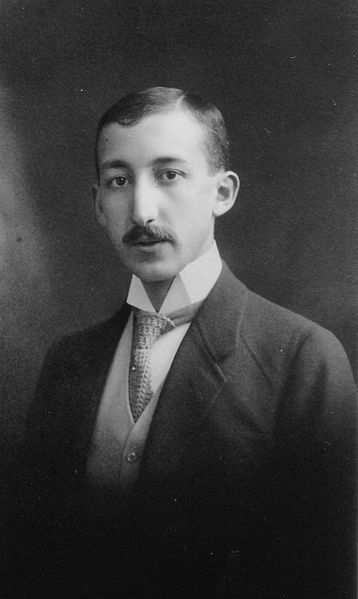<Back to Index>
- Chemist Georg Karl von Hevesy, 1885
- Poet Francis Scott Key, 1779
- Emperor of the Roman Empire Tiberius Claudius Ceasar Augustus Germanicus, 10 B.C.
PAGE SPONSOR

George Charles de Hevesy, Georg Karl von Hevesy, (1 August 1885 – 5 July 1966) was a Hungarian radiochemist and Nobel laureate, recognized in 1943 for his key role in the development of radioactive tracers to study chemical processes such as in the metabolism of animals.
Hevesy György was born in Budapest, Hungary, to a Roman Catholic family of Hungarian Jewish decent, the fifth of eight children from his wealthy parents Lajos (Louis) Bischitz and Eugenia (Jenny) Schossberger. George grew up in Budapest and graduated high school in 1903 from Piarista Gimnázium. The family's name in the 1904 was Hevesy-Bischitz, and Hevesy later changed his own.
De Hevesy began his studies in chemistry at the University of Budapest for one year, and at the Technical University of Berlin for several months, but changed to the University of Freiburg. There he came in contact with Ludwig Gattermann. In 1906 he started his Ph.D. thesis with Georg Franz Julius Meyer, acquiring his doctorate in physics in 1908. In 1908 Hevesy got a position at the ETH. When Richard Lorenz left for the University of Frankfurt and Richard Willstätter tried to convince him to stay in Zurich he decided to go to the University of Karlsruhe to work with Carl Bosch. To learn new methods, de Hevesy joined Rutherford's laboratory at the University of Manchester in 1911 where he met and became friends with Niels Bohr. In 1923 de Hevesy co-discovered hafnium (72Hf) (Latin Hafnia for "Copenhagen", the home town of Niels Bohr), with Dirk Coster. Mendeleev's
periodic table in 1869 put the chemical elements into a logical system,
however there was missing a chemical element with 72 protons. On the
basis of Bohr's atomic model Hevesy came to the conclusion that there
must be a chemical element that goes there. The mineralogical museum of
Norway and Greenland in Copenhagen furnished the material for the
research. Characteristic X-ray spectra recordings made of the sample
indicated that a new element was present. This earned him the 1943 Nobel Prize in Chemistry. Hevesy was offered and accepted a job from the University of Freiburg. Supported financially by the Rockefeller Foundation, he had a very productive year. He developed the X-ray florescence analytical method, and discovered the Samarium alpha-ray.
It was here he began the use of radioactive isotopes in studying the
metabolic processes of plants and animals, by tracing chemicals in the
body by replacing part of stable isotopes with small quantities of the
radioactive isotopes. When Germany invaded Denmark in World War II, de Hevesy dissolved the gold Nobel Prizes of Max von Laue and James Franck with aqua regia to prevent the Nazis from stealing them. He placed the resulting solution on a shelf in his laboratory at the Niels Bohr Institute.
After the war, he returned to find the solution undisturbed and
precipitated the gold out of the acid. The Nobel Society then recast
the Nobel Prizes using the original gold. In 1943, Copenhagen was no longer seen as safe for a Jewish scientist, and de Hevesy fled to Sweden, where he worked at the Stockholm University College until
1961. Interestingly enough, in Stockholm, de Hevesy was received at the
department of German-Swedish professor and Nobel Prize winner Hans von Euler-Chelpin,
who remained strongly pro-German throughout war. Despite this, de
Hevesy and von Euler-Chelpin collaborated on many scientific papers
during and after the war. During
his time in Stockholm, de Hevesy received the Nobel Prize in chemistry.
He later was inducted as a member of the Royal Society and received the Copley Medal,
of which he was particularly proud. The Hevesy stated: "The public
thinks the Nobel Prize in chemistry for the highest honor that a
scientist can receive, but it is not so. Forty or fifty received Nobel
chemistry prizes, but only ten foreign membership of the Royal Society and
two (Bohr and Hevesy) received a medal - Copley." George de Hevesy was
elected a foreign member of the Royal Swedish Academy of Sciences in
1942, and his status was later changed to Swedish member. In 1949 he
was elected Franqui Professor in the University of Ghent. He received the Atoms for Peace Award in 1958 for his peaceful use of radioactive isotopes.
De
Hevesy married Pia Riis in 1924. They had one son and three daughters
together. De Hevesy died in 1966 at the age of eighty and was buried in
the Kerepesi Cemetery in Budapest, Hungary.
He had made a total of 397 scientific publications. At his family's
request, his ashes were interred at his birthplace in Budapest on April
19, 2001.